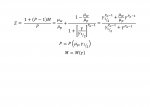Hi,
So my maths skills aren't the strongest so I was hoping someone could help me with a problem that seems fairly trivial but I can't seem to solve.
So I have the following equation:
. . .\(\displaystyle \large{ Z\, =\, \dfrac{1\, +\, (P\, -\, 1)\, M}{P} }\)
. . . . .\(\displaystyle \large{ =\, \dfrac{\mu_w}{\mu_p}\,+\, \dfrac{1\, -\, \dfrac{\mu_w}{\mu_p}}{1\, +\, \left[\dfrac{\gamma}{\gamma_{\frac{1}{2}}}\right]^{P_{\alpha} - 1}} }\)
. . . . . . .\(\displaystyle \large{ =\, \dfrac{\gamma_{\frac{1}{2}}^{P_{\alpha} - 1}\, +\, \dfrac{\mu_w}{\mu_p}\, \gamma^{P_{\alpha} - 1}}{\gamma_{\frac{1}{2}}^{P_{\alpha} - 1}\, +\, \gamma^{P_{\alpha} - 1}} }\)
I need to find P and M such that P is a function of mu_p and gamma_half, and M is only a function of gamma.
. . .\(\displaystyle \large{ P\, =\, P(\mu_p,\, \gamma_{\frac{1}{2}}) }\)
. . .\(\displaystyle \large{ M\, =\, M(\gamma) }\)
mu_w and P_alpha are constants so they can go anywhere. Any help would be greatly appreciated!!
Thanks in advance!
So my maths skills aren't the strongest so I was hoping someone could help me with a problem that seems fairly trivial but I can't seem to solve.
So I have the following equation:
. . .\(\displaystyle \large{ Z\, =\, \dfrac{1\, +\, (P\, -\, 1)\, M}{P} }\)
. . . . .\(\displaystyle \large{ =\, \dfrac{\mu_w}{\mu_p}\,+\, \dfrac{1\, -\, \dfrac{\mu_w}{\mu_p}}{1\, +\, \left[\dfrac{\gamma}{\gamma_{\frac{1}{2}}}\right]^{P_{\alpha} - 1}} }\)
. . . . . . .\(\displaystyle \large{ =\, \dfrac{\gamma_{\frac{1}{2}}^{P_{\alpha} - 1}\, +\, \dfrac{\mu_w}{\mu_p}\, \gamma^{P_{\alpha} - 1}}{\gamma_{\frac{1}{2}}^{P_{\alpha} - 1}\, +\, \gamma^{P_{\alpha} - 1}} }\)
I need to find P and M such that P is a function of mu_p and gamma_half, and M is only a function of gamma.
. . .\(\displaystyle \large{ P\, =\, P(\mu_p,\, \gamma_{\frac{1}{2}}) }\)
. . .\(\displaystyle \large{ M\, =\, M(\gamma) }\)
mu_w and P_alpha are constants so they can go anywhere. Any help would be greatly appreciated!!
Thanks in advance!
Attachments
Last edited by a moderator:

